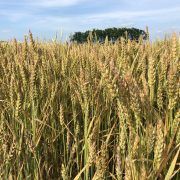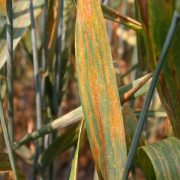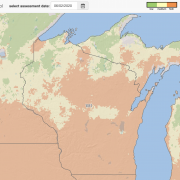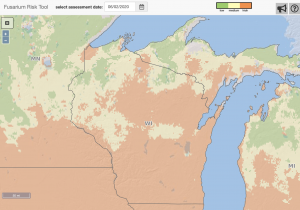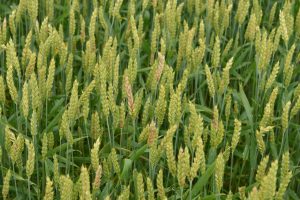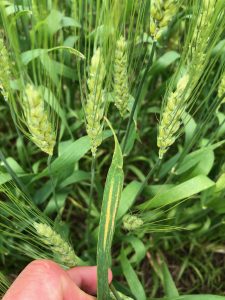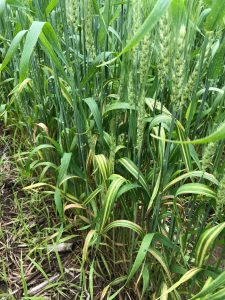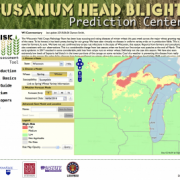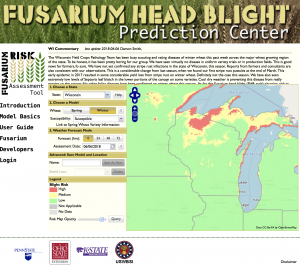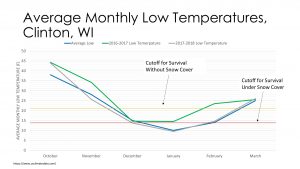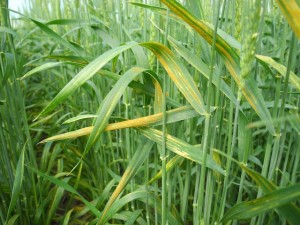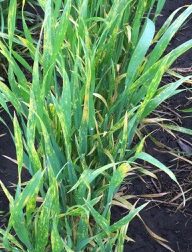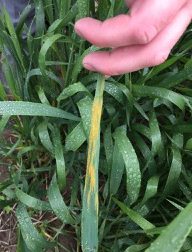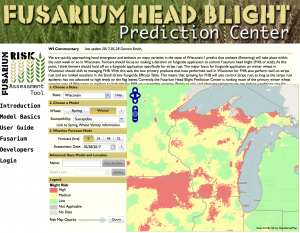Wisconsin Winter Wheat Disease Update – May 16, 2024
Damon Smith, Extension Field Crops Pathologist, Department of Plant Pathology, University of Wisconsin-Madison
Shawn Conley, Extension Soybean and Small Grains Agronomist, Department of Plant and Agroecosystem Sciences, University of Wisconsin-Madison
Winter wheat in Wisconsin continues to move through growth stages at record pace. We are about 10-14 days ahead on growth stages compared to this time in most years in Wisconsin. The warm spring and timely rain has pushed wheat very quickly.
As I mentioned last week, we continue to monitor the stripe rust situation. This week brings us a confirmed stripe rust positive in Tippecanoe Co. Indiana (Fig. 1). As I mentioned in my previous article, the likelihood is high that we will see stripe rust in Wisconsin this season. We have continued to scout for this disease and visited several variety and research location this week in southern Wisconsin. We have not found stripe rust yet. This doesn’t mean that it isn’t here. I still encourage you to scout and let us know if you find it or get it confirmed by our Plant Disease Diagnostic Clinic.
With the rapid growth stage changes happening, we are quickly approaching the time in the season that we need to be aware of risk and in-season management decisions for Fusarium head blight. Fusarium head blight (FHB) has typically been a more frequently occurring issue in Wisconsin. However, in recent years, our spring seasons have been exceptionally hot and dry leading to little disease. However, this season is different with moderate temperatures and adequate precipitation to make FHB an issue. Not only is the disease yield limiting, but the fungus that causes FHB can also produce the mycotoxin called deoxynivalenol (DON or vomitoxin). DON contamination above 2 ppm in finished grain can often lead to discounts at the elevator or outright rejection. Thus, this disease is worth managing.
Fortunately, we have some excellent in-season management options for FHB. Be sure you know the relative susceptibility of the varieties you have planted. We have excellent data showing significant reductions of FHB where we use a resistant variety and then layer a fungicide application on top. Varietal resistance works!
When it comes to fungicides for FHB, there are really just five products to choose from that are rated as “Good” on the “Fungicide Efficacy for Control of Wheat Diseases” table. Timing is everything when using a fungicide for FHB management. Be sure to time applications at the start of anthesis or within 5-7 days after the start. This is the ideal window of opportunity to control FHB and reduce DON levels in the finished grain. Spraying earlier than anthesis or later than about a week after the start of anthesis will result in lost efficacy, or no control of FHB. If you need help with growth staging, be sure to check out the “Visual Guide to Winter Wheat Development and Growth Staging.” Also, the fungicides rated “G” for FHB in the fungicide efficacy table are effective against stripe rust, so if that disease happens to move in now or later, a single application of fungicide at the anthesis timing should take care of both problems.
There is a disease prediction tool for FHB of wheat. You can find that tool at http://www.wheatscab.psu.edu. This tool should be monitored frequently as your crop approaches anthesis and soon after. It can help you determine if your crop is at risk, based on the weather conditions. Risk as of May 16, 2024 for FHB-suscpetible winter wheat varieties is currently estimated to be low (Fig. 2). However, given the 7-day forecast of rain and warm temperatures, I would suspect this to change to be more favorable for FHB risk in the coming 7-10 days. If you haven’t applied a fungicide yet this season, I would urge you to consider one, well-timed application targeting FHB this season.
The ‘Take Home’ for wheat management over the next several weeks.
- Plan to apply an FHB fungicide application – especially on susceptible varieties
- Shoot for Anthesis or up to 5-days after the start of anthesis for the fungicides rated “G” for FHB in this table.
- All of the available fungicides rated for FHB also are effective against stripe rust. Thus, one fungicide can manage both problems!
- You can go slightly earlier (Feekes 10.5; Efficacy slightly reduced compared to typical timing) up to 5-days after the start of anthesis for Miravis Ace to manage FHB.
- Watch the “Scab Alerts” – it isn’t perfect, but can help you make a decision (http://www.wheatscab.psu.edu).

